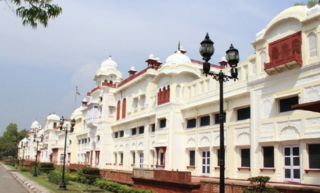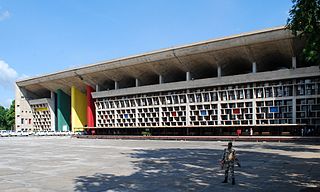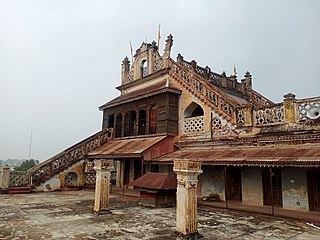| Qila Mubarak | |
|---|---|
| Native name Fort of Baba Ala Singh | |
 | |
| Type | Royal palace of Patiala State |
| Location | Patiala, Punjab, India |
Qila Mubarak is a fortress of Sikh architecture in Patiala, Punjab, India. [1]
| Qila Mubarak | |
|---|---|
| Native name Fort of Baba Ala Singh | |
 | |
| Type | Royal palace of Patiala State |
| Location | Patiala, Punjab, India |
Qila Mubarak is a fortress of Sikh architecture in Patiala, Punjab, India. [1]

Qila Mubarak was first built as a 'Kachigarhi' (Mud fortress) by Sidhu Jat ruler Baba Ala Singh in 1763, [2] who was the founder of the Patiala dynasty. Later, it was reconstructed in baked bricks. It is said that the original fort created in 1763 was an extension built on top of an already existing Mughal fortress built by governor Hussain Khan in Patiala. The interior portion of Qila, which is known as Qila Androon is built by Maharaja Amar Singh. [3]
The residential palace of Royal family of Patiala, Qila Mubarak complex is built in 10-acre (40,000 m2) ground in the Heart of the city. The whole complex contains Ran Baas (Guest house) and the Darbar Hall (Divan Khana) [4] besides Qila Androon. There is also underground sewerage system in the Qila. [5]
Qila Androon has 13 royal chambers with scenes from Hindu mythology painted in the Patiala art style. [6]
The Darbar Hall contains rare cannons, swords, shields and maces, daggers of Guru Gobind Singh, and sword of Nadir Shah. [7]
Being a 300-year-old building, [8] the Qila is described as being in 'bad shape' [9] and has been extensively damaged. [10] The fortress is described by the World Monuments Fund as one of world’s 100 "most endangered monuments" in year 2004. [8]
Restoration work of Qila has been undertaken by Indian National Trust for Arts and Cultural Heritage, which has been financially assisted by the state and national governments [11] Archaeological Survey of India. [12] The World Monuments Watch has also funded its preservation. [13] [14] [15]

Patiala is a city in southeastern Punjab, northwestern India. It is the fourth largest city in the state and is the administrative capital of Patiala district. Patiala is located around the Qila Mubarak constructed by the Sidhu Jat Sikh chieftain Ala Singh, who founded the royal dynasty of Patiala State in 1763, and after whom the city is named.

Bathinda is a city and municipal corporation in Punjab, India. The city is the administrative headquarters of Bathinda district. It is located in northwestern India in the Malwa Region, 227 km (141 mi) west of the capital city of Chandigarh and is the fifth largest city of Punjab. It is the second cleanest city in Punjab after Mohali.

The Shiromani Gurdwara Parbandhak Committee is an organization in India responsible for the management of Gurdwaras, Sikh places of worship in states of Punjab and Himachal Pradesh and the union territory of Chandigarh. SGPC also administers Darbar Sahib in Amritsar.

Captain Amarinder Singh, is an Indian politician, military historian, former royal and Indian Army veteran who served as the 15th Chief Minister of Punjab. A former Member of the Legislative Assembly, Punjab and Member of Parliament, Lok Sabha, he was also the president of Punjab Pradesh Congress Committee. He has also previously served as the Chief Minister of Punjab from 2002 to 2007 and 2017 to 2021. His father was the last Maharaja of the princely state of Patiala. He has also served in the Indian Army from 1963 to 1966. In 1980, he won a seat in the Lok Sabha for the first time. As of November 2022, Singh also serves as the chairman of the Punjab Urdu Academy. Captain Singh resigned as the Chief Minister of Punjab on 18 September 2021. On 19 September 2022 he merged his party PLC with BJP and joined BJP on the same day.

Malerkotla is a city and the district headquarters of Malerkotla district in the Indian state of Punjab. It served as the seat of the eponymous princely state during the British Raj. The state acceded to the union of India in 1947 and was merged with other nearby princely states to form the Patiala and East Punjab States Union (PEPSU).

Punjab and Haryana High Court is the common High Court for the Indian states of Punjab and Haryana and the Union Territory of Chandigarh based in Chandigarh, India. Sanctioned strength of Judges of this High Court is 85 consisting of 64 Permanent Judges and 21 Additional Judges including Chief Justice. As of 14 September 2023, there are 58 Judges working in the High Court, comprising 36 Permanent and 22 Additional Judges.

Nabha is a town and municipal council in the Patiala district in the south-west of the Indian state of Punjab. It was the capital of the former Nabha State. Nabha is also a sub-division city which comes under Patiala district.

Rupnagar is a city and a municipal council in Rupnagar district in the Indian state of Punjab. Rupnagar is a newly created fifth Divisional Headquarters of Punjab comprising Rupnagar, Mohali, and its adjoining districts. It is also one of the bigger sites belonging to the Indus Valley civilization. Rupnagar is nearly 43 km (27 mi) to the northwest of Chandigarh. It is bordered by Himachal Pradesh to the north and Shahid Bhagat Singh Nagar district to its west.

Kesgarh Qila or Takht Kesgarh Sahib, alternatively spelt as Keshgarh Qila, is one of the five takhts of the Sikhs located in Anandpur Sahib in Rupnagar district of Punjab, India.It is located just 40 km from Rupnagar city, the district headquarters and 78 km from state capital Chandigarh. The fort is also called Takhat Keshgarh Sahib. This Gurdwara was one of the forts constructed by Guru Gobind Singh on March 30 1689 at Anandpur Sahib for the defense of the Sikhs. He spent his 25 years at Anandpur Sahib and, to protect the Sikhs from the Rajas of the Hill States and Mughals, began the construction of five defensive Qilas (forts) all around the town.

The Maharaja of Patiala was the title of a Maharaja in India and the ruler of the princely state of Patiala, a state in British India. The first Maharaja of Patiala was Baba Ala Singh (1695–1765).

Sikh architecture is a style of architecture that was developed under the Sikh Confederacy and Sikh Empire during the 18th and 19th centuries in the Punjab region. Due to its progressive style, it is constantly evolving into many newly developing branches with new contemporary styles. Although Sikh architecture was initially developed within Sikhism its style has been used in many non-religious buildings due to its beauty. 300 years ago, Sikh architecture was distinguished for its many curves and straight lines; Keshgarh Sahib and the Harmandir Sahib are prime examples.

Qila Mubarak, is a historical monument in the heart of the city of Bathinda in Punjab, India. It is recognized as monument of national importance and maintained by Archaeological Survey of India. It has been in existence from 1100 to 1200 AD in its current place and is the oldest surviving fort in India. It was here that Razia Sultan, the first woman to take charge of the Delhi throne was incarcerated upon her defeat and dethroned. The bricks of the fort date back to the Kushana period when emperor Kanishka ruled over Northern India/Bactria. Raja Dab, along with emperor Kanishka, is believed to have built the fort. Qila Mubarak in latter part of the 10th Century was under the rule of Jayapala, a ruler of the Hindu Shahi dynasty.

Ramgarhia Bunga or Burj is the three-storeyed red stone watchtowers complex located near southeastern edge of the Golden Temple, Amritsar. The two minaret-style Ramgarhia Bunga high towers are visible from the parikrama (circumambulation) walkway around the Harmandir Sahib Sarovar. It is a pre-Ranjit Singh structure built by Sikh warrior and Ramgarhia misl chief Jassa Singh Ramgarhia in late 18th-century, after the 1762 destruction and desecration of the Sikh holy temple and site by the Afghan Muslim forces led by Ahmed Shah Abdali. The Bunga watchtowers-related infrastructure was constructed to station sentinels to watch for any surprise attack, house soldiers to help fortify the area, and to protect the holy complex from desecration.

Punjab has a long history of education.

The Panjab Digital Library is a voluntary organization digitizing and preserving the cultural heritage of Panjab since 2003. With over 65 million digitized pages, it is the biggest resource of digital material on Panjab. There are many historically significant documents stored and made available online. Its scope covers Sikh and Punjabi culture. The library funded by The Nanakshahi Trust was launched online in August 2009. Its base office is located at Chandigarh, India.

Jind State was a princely state located in the Punjab region of north-western India. The state was 3,260 km2 (1,260 sq mi) in area and its annual income was Rs.3,000,000 in the 1940s. Jind was founded and ruled by Jat Sikh rulers of Sidhu clan.

Patiala State was a self-governing princely state of the Empire of India, and one of the Phulkian States, that acceded to the Union of India upon Indian dominionship and partition. Patiala Kingdom/State was founded by Sidhu Jat Sikhs.
Saraswati Wildlife Sanctuary, also known as Seonsar Forest, is situated in Kaithal district of Haryana State, India. It is spread over an area of 4,452.85 hectares.

The Jathedar of the Akal Takht is the head of the Akal Takht and head of the Sikhs worldwide. The jathedar has the de facto power as the supreme spokesperson of the Khalsa to summon, trial and sentence any person who identifies as a Sikh from the Akal Takht.